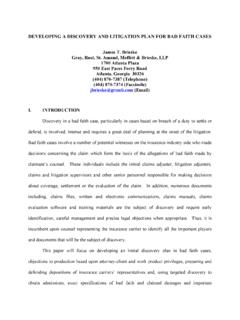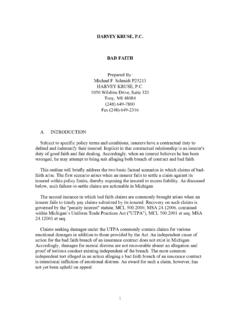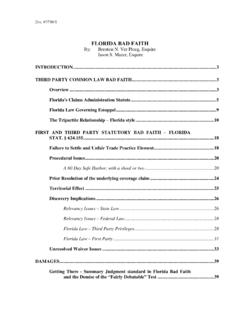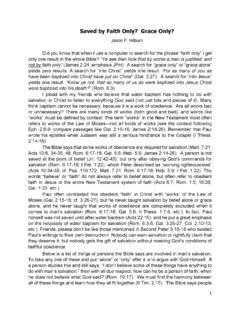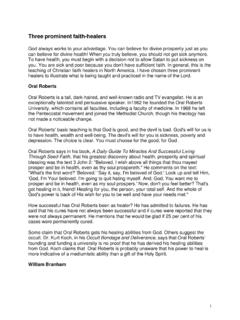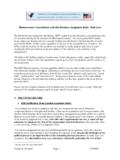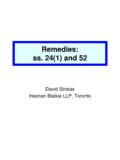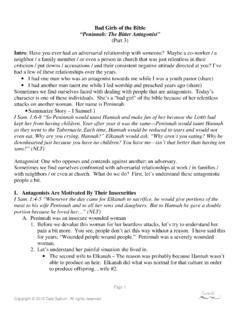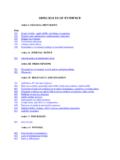Transcription of Developing a Discovery and Litigation Plan for Bad …
1 Developing A Discovery AND Litigation plan FOR BAD faith CASES. James T. Brieske Gray, Rust, St. Amand, Moffett & Brieske, LLP. 1700 Atlanta Plaza 950 East Paces Ferry Road Atlanta, Georgia 30326. (404) 870-7387 (Telephone). (404) 870-7374 (Facsimile). (Email). I. INTRODUCTION. Discovery in a bad faith case, particularly in cases based on breach of a duty to settle or defend, is involved, intense and requires a great deal of planning at the onset of the Litigation . Bad faith cases involve a number of potential witnesses on the insurance industry side who made decisions concerning the claim which form the basis of the allegations of bad faith made by claimant's counsel.
2 These individuals include the initial claims adjuster, Litigation adjusters, claims and Litigation supervisors and other senior personnel responsible for making decisions about coverage, settlement or the evaluation of the claim. In addition, numerous documents including, claims files, written and electronic communications, claims manuals, claims evaluation software and training materials are the subject of Discovery and require early identification, careful management and precise legal objections when appropriate. Thus, it is incumbent upon counsel representing the insurance carrier to identify all the important players and documents that will be the subject of Discovery .
3 This paper will focus on Developing an initial Discovery plan in bad faith cases, objections to production based upon attorney-client and work product privileges, preparing and defending depositions of insurance carriers' representatives and, using targeted Discovery to obtain admissions, exact specifications of bad faith and claimed damages and important documents from the policyholder. Although this paper is based upon my experiences defending bad faith cases based upon a breach of a duty to settle or defend and coverage disputes, these principles can apply when defending insurance carriers in both first and third party bad faith lawsuits.
4 II. Developing THE INITIAL Discovery plan . Although most bad faith cases involve allegations of bad faith concerning a single claim, counsel for policyholders often try to expand the scope of Discovery beyond the single instance of alleged bad faith to establish a course of conduct on the insurance carrier that puts the carrier or insurance industry on trial. Counsel for policyholders attempt, through Discovery , to show an institutional pattern of denying or delaying payment of claims which constitutes bad faith to increase their damages which include punitive damages and attorney's fees that are typically claimed in bad faith Litigation .
5 The first order of business for counsel representing the insurance carrier is to manage and limit the scope of Discovery to the single claim which is the subject of the involved bad faith complaint. Second, counsel for the carrier must identify all players on both the sides of the Litigation that made decisions, know the most about the case, and can get you the documents that you need to learn about the handling of the claim. It is important to immediately identify all individuals who will be asked to give depositions. Counsel should also determine who will ultimately be the company representative sitting at the defense table if the case goes to trial.
6 Initially, counsel must identify each and every person from initial claims adjusters, Litigation adjusters, retained and in-house counsel, and supervisors who participated in the handling of the claim or made decisions concerning settlement or coverage. Counsel must immediately identify what witnesses they will need to depose on the policyholder's side to establish their version of the facts, get a Developing a Discovery and Litigation plan for Bad faith Cases 2. description and basis of their claimed damages and develop facts which may be beneficial to their defense. Once this roster of candidates is developed, counsel for the insurance carrier should immediately meet face to face with their witnesses to learn about the handling of the particular claim and to begin to prepare them for depositions.
7 Last, counsel needs to obtain all documents and materials that will be the subject of written Discovery and depositions, will educate him about the facts of the case, the players involved and what decisions will be scrutinized by plaintiff's counsel. Certainly the claims file is the first and most important evidence to obtain since it will show the handling of the claim from its infancy through the entire claims process. Underwriting documents, correspondence, and any other documents generated which demonstrate an evaluation of the claim for settlement or decision about coverage must be obtained and reviewed.
8 Since these documents will be numerous, a well-organized Bates' stamped document file that can be easily utilized throughout the Discovery process is of the upmost importance. III. USING WRITTEN Discovery TO THE PLAINTIFF TO. DEFEND YOUR CASE. Targeted written Discovery to the bad faith plaintiff will allow counsel to understand the basis of the claim, obtain any and all documents and communications which they contend demonstrates bad faith and identify all witnesses that may be the subject of depositions. In initial interrogatories, counsel should require the policyholder to spell out in detail, the basis of the bad faith claim.
9 Specific interrogatories requiring the plaintiffs to describe all events or decisions that they contend constitute bad faith are essential to learn about the claim. Obtaining exact details including dates, times, subject matter and all persons involved must be drafted. Last, interrogatories should ask the policyholder to identify all decisions, documents and communications which show any event which they consider constitutes bad faith . Developing a Discovery and Litigation plan for Bad faith Cases 3. Next, require policyholders to identify all specific policy provisions applicable to the events which form the basis of their bad faith claim.
10 The policyholders contend the insurance company violated code sections, ethical standards or internal or general claims handling guidelines they must be asked to identify the same. A description of each and every instance in which a policy provision was violated should be described in detail. The policyholder must also be required to describe all elements of their damages claim. The recent trend in breach of settlement and duty to defend cases is to greatly expand the scope of damages claimed by the policyholder. Thomas v. Atlanta Cas. Co., 253 Ga. App. 199, 558. 432 (2001) describes the scope of damages a policyholder may claim as a result of a breach of a duty to defend and failure to timely settle.
